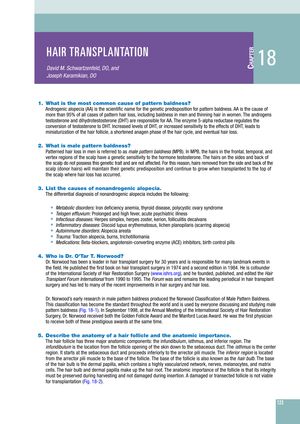Hair Transplantation: Causes, Techniques, and Future Prospects
January 2010
in “
Elsevier eBooks
”
hair transplantation androgenic alopecia testosterone dihydrotestosterone DHT metabolic disorders infectious disorders inflammatory disorders autoimmune disorders trauma medications Norwood Classification male pattern baldness edema folliculitis infection wound dehiscence finasteride minoxidil cloning nanotechnology follicular unit extraction FUE donor area harvesting Propecia Rogaine

TLDR Hair transplantation is a treatment for hair loss mainly caused by genetics, with various techniques and potential complications, and results visible after 8-12 months.
The document from January 1, 2010, discusses hair transplantation, identifying androgenic alopecia (AA) as the cause of over 95% of pattern hair loss, influenced by testosterone and dihydrotestosterone (DHT). Other causes of hair loss include metabolic, infectious, inflammatory, autoimmune disorders, trauma, and medications. It acknowledges Dr. O'Tar T. Norwood's contributions, particularly the Norwood Classification for male pattern baldness. Hair transplantation requires careful planning of the hairline, donor area harvesting, and managing the patient's donor supply, with complications such as edema, folliculitis, infection, and wound dehiscence possible. Medical treatments mentioned include finasteride and minoxidil, with future prospects like cloning and nanotechnology. Follicular unit extraction (FUE) is described as having advantages like shorter recovery and no linear scar but also disadvantages like higher rates of follicle damage and a limit of 400 to 600 grafts per session. Full transplant results can take 8 to 12 months to appear.




